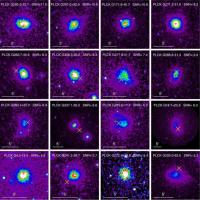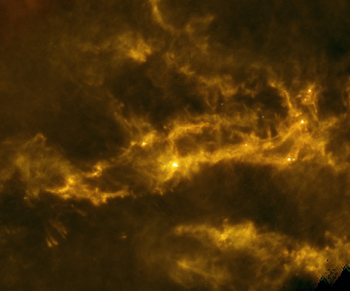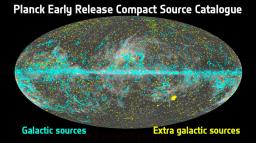News 2011
An international team, including scientists from the Astrophysics Department-AIM and the Particle Physics Department of CEA-Irfu, has just used the Planck satellite to discover galaxy clusters with characteristics that were previously unknown. These clusters, which contain up to a thousand galaxies, are the largest structures in the Universe. Many of them are located very far away from us, and we still know relatively little about them. Astrophysicists were able to detect the new clusters thanks to the imprint left in the background radiation of the universe by the hot gas from the clusters. Of the 189 clusters detected by Planck at distances from 1 to 5 billion light-years, 20 were previously unknown. Thanks to a joint program with the XMMNewton x-ray satellite, some of these new clusters could be observed, revealing weaker luminosity and a highly perturbed gas distribution. These must therefore be clusters with different characteristics.
These results were presented at a scientific colloquium on results from the Planck satellite, held from 10th to 14th January 2011 in Paris. They were published in a special issue of Astronomy & Astrophysics.
For a more detailed account, see also the French version.
The Herschel space telescope of the European Space Agency (ESA) has given astrophysicists unpublished images of interstellar filament networks, in which the majority of stars are formed. By combining these observations with theoretical models, the researchers were able to characterize these filaments precisely, a further advance in understanding where and how stars are born. This work of an international team coordinated by the Astrophysics Laboratory - AIM Paris Saclay Laboratory (CEA-Irfu - CNRS - Paris Diderot University) is published online in Astronomy and Astrophysics on 13 April 2011.
Read more in the French version
Waves traveling inside the core of a giant star have been discovered by a international team of researchers including Rafael A. Garcia, member of the Service d'Astrophysique of CEA-Irfu [1]. The results were obtained using 320-day observations of the Kepler satellite by means of stellar seismology. These waves, known as gravity modes, produce very small changes in the brightness at the surface of the star. The vibrations of the star offer the possibility of measuring the density, chemical composition, and the internal rotation of the star otherwise inaccessible. So far, these waves could only be unveiled for the Sun. The Sun will become a red giant in about 6 billion years. This discovery thus provides a crucial diagnosis on the future of our star. These results are published in Science- magazine on March 17, 2011.
An international team, including scientists from the Astrophysics Department-AIM and the Particle Physics Department of CEA-Irfu, has just used the Planck satellite to discover galaxy clusters with characteristics that were previously unknown. These clusters, which contain up to a thousand galaxies, are the largest structures in the Universe. Many of them are located very far away from us, and we still know relatively little about them. Astrophysicists were able to detect the new clusters thanks to the imprint left in the background radiation of the universe by the hot gas from the clusters. Of the 189 clusters detected by Planck at distances from 1 to 5 billion light-years, 20 were previously unknown. Thanks to a joint program with the XMMNewton x-ray satellite, some of these new clusters could be observed, revealing weaker luminosity and a highly perturbed gas distribution. These must therefore be clusters with different characteristics.
These results were presented at a scientific colloquium on results from the Planck satellite, held from 10th to 14th January 2011 in Paris. They were published in a special issue of Astronomy & Astrophysics.
For a more detailed account, see also the French version.
The scientific community had to wait 18 months for the data collected by Planck, the European Space Agency satellite. Now, the first scientific results are in. The first edition of the compact sources catalog (ERCSC, Early Release Compact Sources Catalogue), with several thousand sources detected by Planck, has been published and presented in the context of an international colloquium, held from 11th to 14th January 2011 at the Cité des Sciences et de l'Industrie in La Villette (Paris).
Read the joint press release from CNES, CNRS, CEA, and ESA
Also refer to the program of the colloquium
|
Contact:
|




